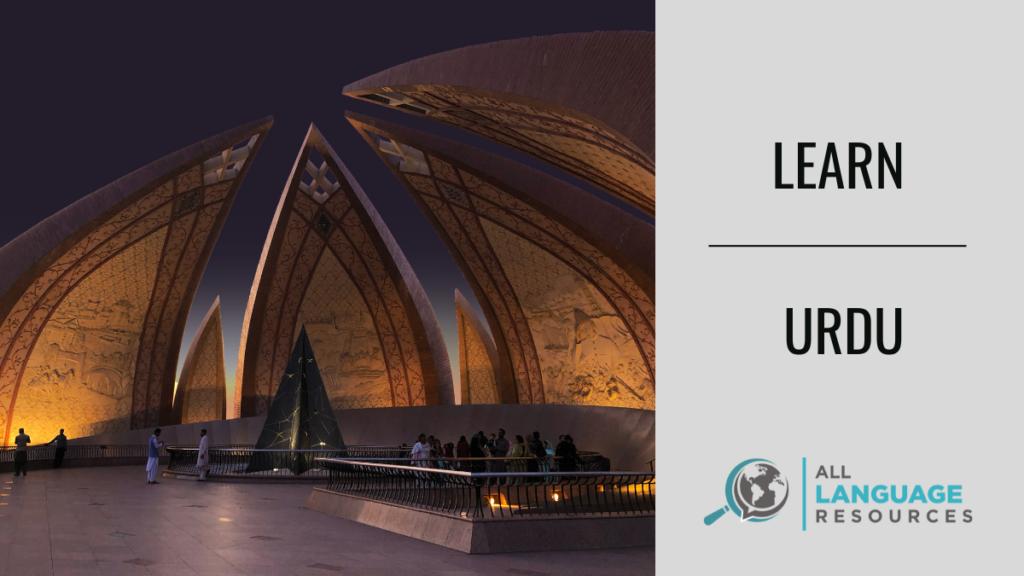Ask most people what they think about Urdu, and they’ll tell you it’s a beautiful language – one of poetry, politeness, and history. Ask them how to study it, and they might shrug and point you to a poetry reading or TV show. If you’re lucky, they’ll have some advice for practicing the Urdu script Nastaliq.
Unlock the secrets of learning Urdu. Best resources? Guides? Tips? Is Urdu hard to learn? What’s the best and easiest way to learn Urdu? Find out here.
Learning a language through poetry, however, is far easier said than done. Fortunately, there are many more Urdu language-learning resources than most people realize. Keep reading as we explore a few resources for learning Urdu.
Plus, we’ll explore how difficult it is, the differences that set it apart from Hindi, and how to create your own self-study plan.

Learn Urdu: A Brief Introduction to the Urdu Language
Urdu is often thought of as the language of Pakistan and Muslim South Asia. Yet this is overly simplistic.
While Urdu is the official language of Pakistan, it’s also spoken in parts of northern India – where it is one of the 22 official languages – as well as in Bangladesh, Nepal, and many other countries in the region. You’ll overhear it being used in the US, the UAE, and the UK (it is England and Wales’ fourth most-spoken language), as well as in other diaspora communities, too.
According to Ethnologue, there are 171 million Urdu speakers in the world. The region’s polyglotism may have led to this number being underestimated.
Meanwhile, there are 74 languages spoken in Pakistan, and Urdu isn’t even the most common. That honor belongs to Punjabi.
Another area of misconception is Urdu’s relationship with Hindi. Some say that they’re the same language. Others strongly disagree. Let’s look at how close they really are.

Urdu vs Hindi: A Tale of Two Sisters
Urdu and Hindi are sister languages, which means that they are descended from the same historical language. They have a striking amount in common, with many people considering them to be mutually intelligible in spoken conversation.
Urdu first appeared in the 1100s and 1200s in and around Delhi. Its emergence has been tied with increasing Islamic and Middle Eastern influence in the region, with the 350-year-long Delhi Sultanate starting in 1206.
Because of this, Urdu has Arabic, Persian, and Turkish influences. Its vocabulary, however, owes more to Sanskrit than to Middle Eastern languages.
Grammatically and phonetically, Urdu is so similar to Hindi that the two languages are often described as being one and the same. There are some differences, especially in the prefixes and suffixes, yet these don’t generally hinder aural comprehension.
When it comes to reading and writing, however, the two languages are visibly different. Urdu uses an adapted Arabo-Persian script called Nastaliq. This is a right-to-left script written with cursive.
Meanwhile, Hindi is written in Devanagari, a Sanskrit script.
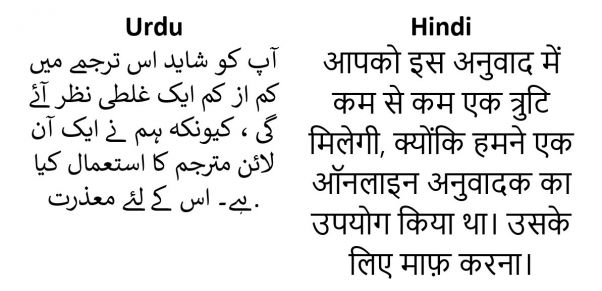
According to the National Council For Promotion Of Urdu Language in India, the perceived differences between Hindi and Urdu are relatively modern. The council argues that the distinction we have today owes a lot to the British colonization of India. The British-led Partition of India into two countries – Hindu-majority India and Muslim-majority Pakistan – only exacerbated this.
So, how different are the two languages, really?
It’s easy to under- or overstate the differences between Urdu and Hindi. On the one hand, Urdu is not just Hindi with an Arabic script: there are distinct linguistic differences, however slight they may be. On the other hand, they are mutually intelligible and were often considered the same language just a couple of hundred years ago.
Regardless of Urdu’s relationship with Hindi, one thing is clear: it’s not solely the language of Pakistan’s Muslim community.
Urdu can boast of a rich literary, linguistic and historical heritage across the region. It’s been used by Sikh and Hindi writers as well as Muslim ones. You’ll see it written on the walls of the Harmandir Sahib, and it was spoken by Emperor Shah Jahan, the man behind the creation of the Taj Mahal.
It is a language of both India and Pakistan and has continuing relevance to the millions of people who speak it in South Asia, the Middle East, and around the globe.
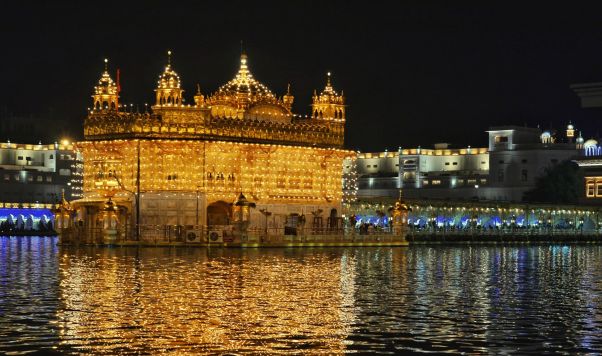
The Harmandir Sahib at night.
How to Learn Urdu: Get Started!
If you Google “how to learn a language,” you’ll find hundreds of language-learning hacks and schedules – but you’ll see the quickest progress if you create your own study plan.
After all, nobody else has your personality, learning style, interests, and goals.
It’s worth taking the time to grab a pen and paper and answer these questions:
- What do I want to be able to do in Urdu?
- How well do I want to be able to do this?
- How much time do I have to study?
- Which study methods do I find effective?
Bear in mind that you’ll probably want to update the answers to these periodically. In fact, you might not even be able to answer the last question right now.
But once you’ve got some answers, you’ll find it easier to create your study plan. For example, if your goal is to speak to family members in Urdu, you’ll want to focus heavily on your speaking, listening, and pronunciation. You might also have an idea of the type of vocabulary you’ll need, depending on what you normally talk about with your family. And you’ll likely want to achieve a fairly high level of proficiency.
Alternatively, if you want to read and listen to Urdu ghazals, you should focus mostly on your reading and listening. And if you’re planning a three-week trip through Pakistan, speaking, listening, and reading will all come in handy – but you probably won’t be worried about a few grammatical errors here and there.
Next, think about how long and often your study sessions will be. It’s better to study a little most days than to have a weekly Urdu learning marathon.
At the same time, it doesn’t make sense to schedule an hour each day if that’s going to exhaust you. Be realistic about how much time you have and don’t push yourself so hard that you end up resenting Urdu. Give yourself days off when you need them.
After all, you want to enjoy learning Urdu – not feel punished by it.

Now that you’ve got your study sessions penciled into your diary, it’s time to work out what exactly to do in those sessions. Take a trial-and-error approach: there are numerous ways to learn a language, and someone else’s favorite method could seem mind-numbingly boring to you.
We’ll explore a huge number of Urdu language courses, podcasts, apps, and more in this article. However, you might also like to:
- Keep a journal to work on your vocabulary, grammar, and written fluency
- Record yourself speaking in Urdu and listen back
- Compare your recordings to a native speaker’s recordings (e.g. from an audiobook or YouTube video) so you can spot areas to improve your pronunciation
- Join Urdu-language Facebook groups and forums
- Follow Urdu-speaking influencers and Urdu-language hashtags
- Find local groups and practice partners
- Create your own pen-and-paper flashcards (although we’ve listed a few flashcard apps below!)
- Have a go at writing Urdu poetry
- Write a letter to the editor of an Urdu-language newspaper – it’s old-fashioned, but it’s still an opportunity to practice!
No matter what study methods you choose, be patient. Learning Urdu (or any other language!) takes time, effort, and resilience. There will be moments when you get frustrated by your vocabulary or feel like your listening was better yesterday. However, as long as you are consistently studying, you will get there.
Focus on your achievements. If you feel demotivated, look back at something you wrote or read a few months ago to see just how far you’ve come. You’ll be surprised at how much you’ve improved.
After all, it’s hard to notice the progress on a day-to-day basis – yet sooner or later, you’ll find yourself confidently using Urdu and getting compliments on your accent.
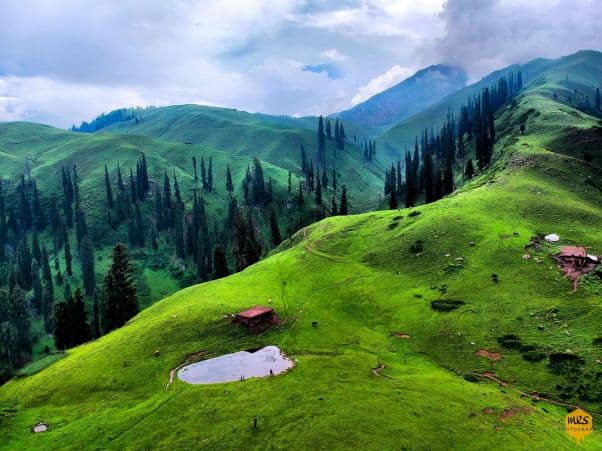
Is Urdu Hard to Learn?
According to the US Foreign Services Institute (FSI), Urdu is “hard” (although not as hard as Arabic or Chinese, and no harder than Hindi). They believe that it takes an average of 44 weeks of intensive study or 1,100 classroom hours to achieve working proficiency. If you’re used to the CEFR’s levels, this has been equated to both B2 and C1.
Yet don’t let the FSI’s analysis put you off learning Urdu.
First of all, no language is truly easy. Even ones like Spanish and German, which have a lot in common with English, take hard work and a significant amount of time to master.
And if you’re going to put all that effort into learning a language, shouldn’t it be a language that you’re passionate about rather than the one that’s “least difficult?” A language that you find beautiful, useful, or culturally significant in some way?

The truth is, the less interesting you find speaking and studying a language, the more challenging it’s going to seem. If you’re struggling with Urdu grammar or pronunciation, you’re certainly not alone. But if you find yourself getting demotivated, try searching for a different study method or a more enjoyable way to use Urdu before writing it off as “impossible.”
Learning a language can be exasperating, mind-boggling, and just plain old confusing. Sometimes, you wonder if you’ll ever pronounce a phoneme right. But it can also be incredibly satisfying, not to mention fun – especially once you start to have deep conversations or discover your favorite Urdu-language TV series and authors.
So, no, Urdu isn’t the world’s easiest language (although you’ll have a large head start if you already speak Hindi). However, with a little bit of hard work, you’ll soon find yourself not only speaking it but enjoying doing so.

What’s the Best Way to Learn Urdu?
Enrolling in a structured course is considered the best way to learn Urdu due to the organized and systematic approach it provides. These courses typically offer a well-designed curriculum that covers essential aspects such as grammar, vocabulary, and pronunciation. A structured course offers a clear progression, ensuring learners build a solid foundation before advancing to more complex language skills. The guidance of experienced instructors and the availability of interactive exercises and assessments enhance the learning experience.
Additionally, the structured nature of the course enables learners to track their progress, receive constructive feedback, and stay motivated throughout their language learning journey. This method offers a comprehensive and efficient way to grasp the fundamentals of Urdu, making it an effective choice for individuals seeking a disciplined and supported path to language proficiency.
What’s the Easiest Way to Learn Urdu?
Watch Urdu movies, TV shows, listen to Urdu music, or podcasts. Exposure to authentic content enhances listening skills, pronunciation, and cultural understanding.
Some popular Urdu language films you may wish to watch are:
1. Waada (2016)
Directed by Yasir Nawaz, this romantic drama features popular Pakistani actors like Shaan Shahid and Ayesha Khan.
2. Punjab Nahi Jaungi (2017)
Directed by Nadeem Baig, this romantic comedy-drama stars Humayun Saeed and Mehwish Hayat. It was a commercial success and received positive reviews.
3. Cake (2018):
Directed by Asim Abbasi, “Cake” is a family drama that received critical acclaim for its storytelling and performances, particularly those of Aamina Sheikh and Sanam Saeed.
4. Load Wedding” (2018)
Another film directed by Nabeel Qureshi, this comedy-drama stars Fahad Mustafa and Mehwish Hayat. It addresses social issues with humor and received positive reviews.
5. Laal Kabootar” (2019)
Directed by Kamal Khan, this crime thriller was well-received for its intense storyline and performances, including those of Ahmed Ali Akbar and Mansha Pasha.
How Long Does it Take to Learn Urdu?
Generally speaking, Urdu is considered a harder language to learn than English but easier to learn than Arabic.
A basic level of Urdu can be achieved in 720 hours of dedicated study. To gain complete fluency, a dedicated effort of 1100 hours is needed.
How to Learn Urdu Fast
Cultural immersion is a fast and effective way to learn Urdu because it places language learning within its authentic cultural context. By immersing oneself in Urdu-speaking environments, learners are exposed to the language’s nuances, colloquial expressions, and real-life scenarios. This direct engagement accelerates the learning process, as individuals naturally adapt to the language through daily interactions, whether it be in conversations, observing cultural practices, or consuming native media.
Cultural immersion not only enhances linguistic proficiency but also provides a deeper understanding of the social and cultural dynamics embedded in Urdu, making the learning experience more comprehensive, practical, and enjoyable. The exposure to diverse aspects of Urdu culture accelerates language acquisition by offering a holistic and immersive approach to mastering both the language and its cultural intricacies.
Additional Urdu Learning Resources
Having supplementary resources in your study plan is a huge plus if you’d like to reach fluency. Interacting with several types of media could help you understand how the Urdu language is used.
Urdu Textbooks
While courses, apps, and online classes can go a long way to learning Urdu and improving your conversational fluency, a textbook can give your studies structure and a sound grammatical basis.
Beginning Urdu: A Complete Course is an expensive but highly praised university-level textbook that’s designed to take you from complete beginner to high-intermediate. Make sure it comes with the CD before buying it. Let’s Study Urdu: An Introductory Course (Yale Language)has clear and easy-to-follow explanations. You’ll need to have either learned the Urdu script beforehand or also purchased Let’s Study Urdu: An Introduction to the Script (Yale Language). Teach Yourself Complete Urdu is good for beginners. It’s focused on travel and tells the story of a Pakistani family going on holiday to Delhi. Although it includes a detailed breakdown of the script (and some brief exercises), you don’t need to have mastered it in order to use the textbook: all Urdu vocabulary and phrases are written both in the Nastaliq script and Roman letters. Learn Urdu in 30 Days by R. S. Ganathe is a more affordable option. Some learners find it too superficial to give you a solid foundation in the language, however.
Urdu Books and Poetry
Urdu is a language of poetry. Don’t worry, though: there’s also plenty of prose for you to get stuck into.
The revolutionary and anti-imperialist Faiz Ahmed Faiz is one of the most famous 20th-century Urdu poets and was nominated four times for the Nobel Prize for Literature. Or, if you’re looking for ghazals, try Mizra Ghalib.
You can also read poetry on rehkta (change the language from Urdu to English to read a Romanized version of the poems) or listen to readings on YouTube – just search for mushaira or مشاعرہ. And if you have any questions about the poems, or want to write and share your own, check out the Urdu poetry subreddit on Reddit.
Urdu: Readings in Literary Urdu Prose will help intermediate Urdu learners ease into reading Urdu. The stories get progressively more challenging.Alternatively, if you don’t mind reading from a webpage, you might like Hindi and Urdu Since 1800: a Common Reader and this Digital Urdu Ghazal Reader hosted by the University of Columbia.
If you want to read something more modern, try Naiyer Masud’s award-winning short stories or Mohammad Ilyas’ novels. Farhat Ishtiaq and Umera Ahmad are both prolific romance novelists whose books have been turned into TV shows and audiobooks. Romantic, Islamic Urdu fiction is thriving, with plenty of recommendations and reviews on Goodreads. And if you’re stuck for ideas about what to read, UrduFiction.com can help you find a book.
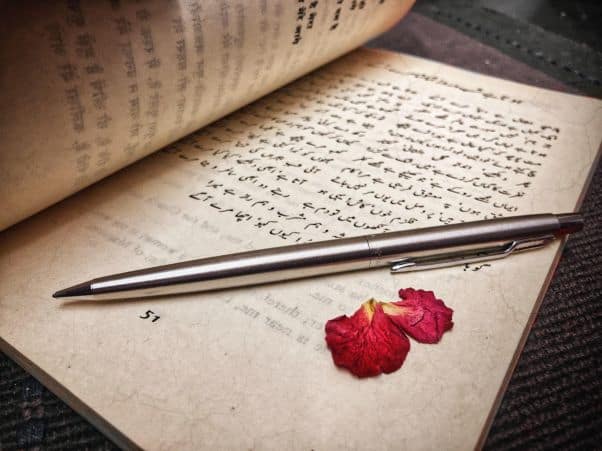
Urdu TV Shows and Movies
Love drama? You’re in luck: you’ve got plenty to choose from. And while it can depend on your location, several of these are (at the time of writing) on Netflix.
In Churails, four women band together to expose cheating husbands. It’s been hailed as a groundbreaking drama of exceptionally high quality.
Udaari tells the story of a mother and daughter and their love lives. While that might sound lighthearted, this show can be heavy-hitting.
Zindagi Gulzar Hai is a touching, romantic drama that doesn’t shy away from race, class, and gender issues.
Humsafar tells the story of an initially loveless marriage, emphasizing the importance of respect within a relationship.
Looking for less romance, and more action? Try Dhuwan, the story of five friends turned vigilantes. Or you might like Ho Mann Jahann, a coming-of-age musical.

News, Music, and Other Resources for Learning Urdu
Listening to Urdu-language music can introduce you to new vocabulary, challenge your listening, and simply get you to spend more hours of the day immersed in Urdu. It’s worth listening to playlists and compilations like this to find artists you like. Alternatively, artists who produce (at least some) songs in Urdu include Atif Aslam, Hadiqa Kiana, Jagjit Singh, Ali Zafar, Qurat-ul-Ain Balouch, and Gulzar.
Meanwhile, reading the news will not only keep you up to date on current affairs but also help you recognize nuance and expand your vocabulary. Just like with the English-language media, it’s worth reading a few different sites until you find one whose editorial angle you like.
For Pakistani news, you could try Urdu News, Daily Pakistan, Daily Khabrain, Jang, or Daily Ausaf. For an Indian perspective, try The Inquilab, The Wire Urdu, or Milap. You might also like BBC News in Urdu.
You’ll likely find yourself reaching for a dictionary as you read all these sites. Try Platts Dictionary, hosted by the University of Chicago. It’s also available as an app.

It’s easy to feel dispirited when you set out to study Urdu and discover that it’s not on Duolingo, Rosetta Stone, or many of the other major language-learning platforms. Yet there’s a surprisingly wide range of ways to learn this beautiful language. So, try out some apps and courses, start practicing your writing, and get ready to finally speak and write Urdu.
Related Posts
If you found this article useful, you might also like:

